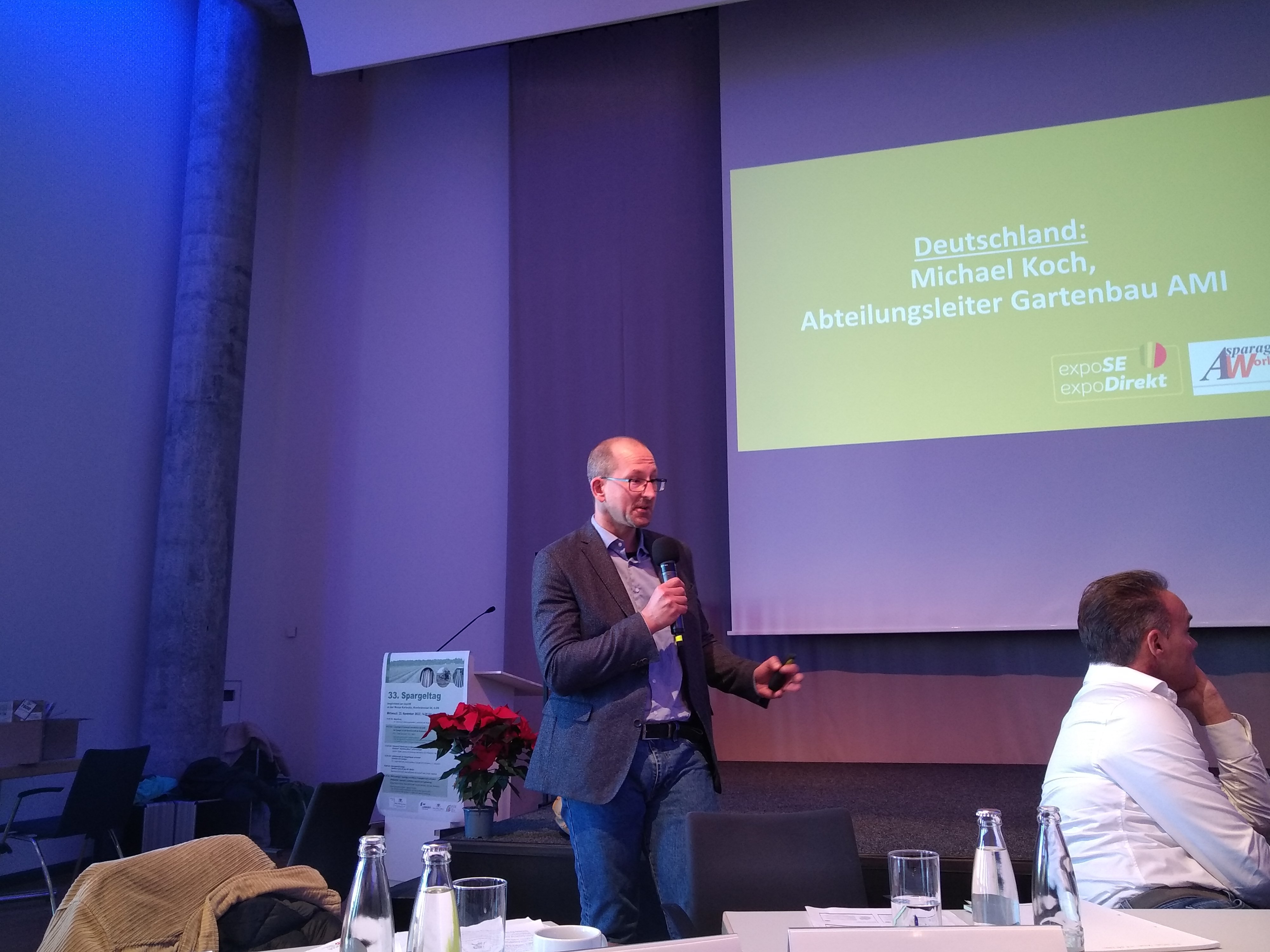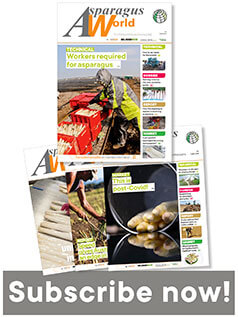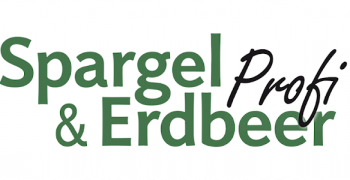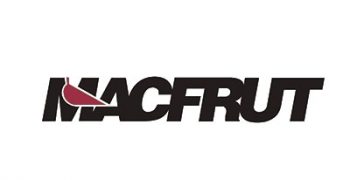Why Germany is cutting back on its asparagus crop
With a volume of 110,300 tons, Germany grew 40% of Europe’s asparagus crop in 2022. But Europe’s exporter countries needn’t fear, says AMI’s Michael Koch, because “we keep almost all our asparagus for ourselves – we don’t export much.” He was among the speakers at the International Asparagus Meeting held last November 23 as part of the asparagus and berry show, ExpoSE in Karlsruhe, Germany. Koch, head of Horticulture at AMI, Germany’s expert in agricultural market intelligence, provided a snapshot of supply and demand in the German asparagus market and a glimpse of where it may be headed in 2023.
Asparagus production declining in Germany
Koch started by outlining the changing production dynamic in Germany, where the volume has been on a downward slope in the last five years. The country reached a record of 133,020 tons in its asparagus production in 2018 which was “followed by very low prices, so in the last few years, production has reduced,” he said. The total asparagus acreage in Germany in 2022 was 25,046 ha, which was 2.5% below the previous year. The area actually in production in 2022, 21,267 ha, was down 5% YoY, while the area not used for production increased 11%. The harvest total of 110,300 tons was 7.5% under that of 2021 and Koch said a further drop is expected for the 2023 season, “because there was very weak demand in 2022 due to consumer uncertainty and we saw a decrease in prices, so some of the producers decided to stop harvesting before the time.” The average yield in 2022 was 5.19 t/ha, which was 3% lower than in 2021. and “we expect this number to be a bit lower in 2023,” Koch said.
Cultivation methods and how the harvest is rolled out
Covering the asparagus rows with plastic foils is the norm in Germany, where only about 10-14% of the planted area is without cover. Black or white covers are used for 84% of the area, triple cover for about 7% and perforated foil 2%. Mini tunnels account for 41% of the planted area. The harvest season kicks off in February with small quantities from some heated production areas, “but we’ll have to see if this is possible in the coming years due to the high cost of energy,” Koch said. After the heated cultivation the harvest moves to the plants under triple cover, double cover and then single cover with black or white top. “The challenge in most years is the time between April and May when all the acreage is in harvest and if the temperature is high and there’s a lot of sun, there is too much supply for the demand we have in Germany and this is always the time when prices go down in Germany,” Koch said. Last year the prices were too low to cover the rising production costs, he said.
Market supply and distribution channels
Of the 110,300 tons produced in 2022, producer organisations accounted for only about a tenth, “which is not very high,” Koch said, adding that there are many different players in the German market, which can sometimes be problematic for the market operation. Adding the imports to the domestic production made for a market supply of 129,800 tons in 2022, from which losses along the value chain to the tune of 28,400 tons are deducted, as well as Germany’s exports of 2,900 tons, to arrive at a total of 98,600 tons available for domestic consumption last year.
Asparagus still regarded as a specialty item in Germany
While white asparagus accounts for a 90% share of German production and green 10%, the relative shares are different when it comes to consumer demand in the country. Koch said German shoppers are shifting a little bit towards more green asparagus consumption, an area of demand that is mostly supplied by imports. Germans may have a reputation as the European champions of asparagus consumption, but Koch explained that, “there was very weak demand in 2022 due to consumer uncertainty and we saw a decrease in prices.” Overall, per capita consumption of fresh asparagus averaged 1.17 kg in Germany in 2022, compared to 1.33 kg in 2021 and 1.28 kg in 2020. Of the about 98.600 tons available for domestic consumption in Germany in 2022, private households accounted for 72% (70,971 t) and HoReCa for 28%. Koch highlighted that 61% of the private household purchases are from food retailers (about 43,200 tons in 2022), of which the share for discounters was just 33%. “This is very different to vegetables in total, for which discounters hold a (retail) share of around 50%, so asparagus is still a specialty.” He said a similar dynamic is seen in the non-retail segment, which accounts for 38% of sales to private households (27,200 tons), where at 18%, the share of asparagus bought direct from farms is very high, “much higher than for vegetables in total.”
Most of Germany’s fresh spear imports are green
April and May are the months when Germany imports most fresh asparagus, with Spain and Greece being the top source countries, followed by Italy, Peru and other countries. “Mexico is becoming a new big player and a substitute for the asparagus coming from Peru,” Koch said. Germany is 86% self-sufficient in fresh asparagus but nevertheless imported about 19,500 tons of fresh asparagus in 2022, “which was a low number,” said Koch, given that in other years it’s usually between 22,000-26,000 tons. While it’s currently not possible to quantify, the majority of the imports are understood to be green asparagus, with only small volumes of white asparagus imported, he said. Germany also exports asparagus, some in April and the majority in May, “but don’t be afraid,” Koch told audience members from other produce countries, “because as you can see, we are talking about less than 5,000 tons, which is a very small share of the total production.”
Rising seasonal worker costs a challenge
While in 2020 it was difficult to bring in harvest workers due to the pandemic, the availability of labour was better in 2021 and again last year. It’s estimated that Romania is the origin of 80% of the harvest workforce, followed by Poland with 15%, and 5% coming from other counties, such as Croatia and Bulgaria. During the harvest, the incentive (performance) wage is most common but other work is paid by hourly wages. The latter is one of the big challenges for the sector, “because in October, 2022, the minimum wage rose to €12 gross, an increase of 22% compared to the previous season,” Koch said. In exceptional cases, short-term employment conditions can apply, under which social security contributions aren’t required. For about 30% of employees on German asparagus and berry farms, however, social security contributions must be paid by the employer, which means an additional cost to the tune of about 20% of the gross wages.
Diseases and pests
Germany generally didn’t have too many problems with diseases and pests last year however, during spring of 2022 there was a strong and long-lasting wave of the asparagus beetle which caused significant damage to green asparagus crops. In September, there was a small outbreak of the small asparagus aphid but it did not affect a large area and was largely without consequences. Similarly, there was one outbreak of asparagus fly last year, once again without significance. Also, last season’s drought and warm weather did not cause any significant disease pressure. There were some cases of Stemphylium but of no great importance. There was a short period of asparagus rust in spring and in August there was rust in almost all regions but seemingly with no consequences, Koch said. On the drought, Koch added, “We had to irrigate the plantations after the harvest so that meant another cost for production.”























